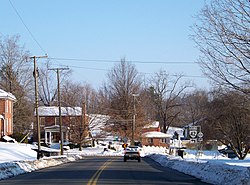Churchville, Virginia
Churchville | |
|---|---|
 | |
Location in the Commonwealth of Virginia | |
| Coordinates: 38°13′34″N 79°09′44″W / 38.22611°N 79.16222°W | |
| Country | United States |
| State | Virginia |
| County | Augusta County |
| Elevation | 1,424 ft (434 m) |
| Population (2010) | |
| • Total | 194 |
| Time zone | UTC−5 (EST) |
| • Summer (DST) | UTC−4 (EDT) |
| GNIS feature ID | 1492769[1] |
Churchville is a census-designated place (CDP) in the western part of Augusta County, Virginia, United States. The population as of the 2010 Census was 194.[2][3] Churchville is part of the Staunton–Waynesboro Micropolitan Statistical Area.
An 1855 gazetteer described the village as a stagecoach stop that contained "2 churches, 2 stores, and 2 schools."[4] Churchville was a famous town during the time of the Civil War. W. Taylor Reveley III, 27th President of the College of William and Mary was born in Churchville.
Churchville is a tree-lined community that is home to several churches (currently 4), the Churchville Public Library, part of the Augusta County Library Branch, and Churchville Elementary School (Grades K-5).
Hanger Mill was listed on the National Register of Historic Places in 1991.[5]
References
[edit]- ^ "Churchville". Geographic Names Information System. United States Geological Survey, United States Department of the Interior.
- ^ "U.S. Census website". United States Census Bureau. Retrieved 2011-05-14.
- ^ Virginia Trend Report 2: State and Complete Places (Sub-state 2010 Census Data). Archived 2012-07-11 at archive.today Missouri Census Data Center. Accessed 2011-06-08.
- ^ Edwards, Richard (1855). Statistical Gazetteer of the State of Virginia. Richmond, Virginia: Richard Edwards. p. 209.
- ^ "National Register Information System". National Register of Historic Places. National Park Service. July 9, 2010.



